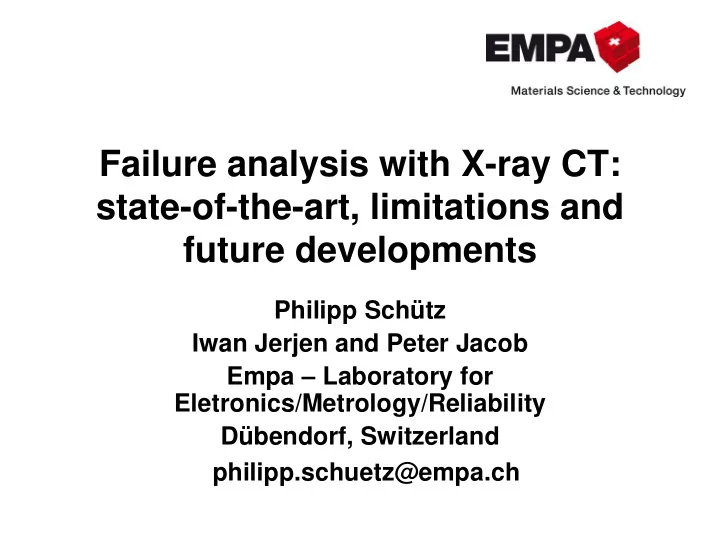

Failure analysis with X-ray CT: state-of-the-art, limitations and future developments Philipp Schütz Iwan Jerjen and Peter Jacob Empa – Laboratory for Eletronics/Metrology/Reliability Dübendorf, Switzerland philipp.schuetz@empa.ch
Purpose • Review applications of CT for failure analysis in electronics and systems • Discuss limitations of current CT technology • Provide an outlook on future technologies important for failures analysis 2
Outline • How to record a Computed Tomography? • Which errors on IC and board level can be identified? • How to investigate time-dependent phenomena and errors on system level? • Where are the current limitations? • Which future developments might close the gap? • What did we learn? 3
How does a CT work? Generic setup CT-system source object detector array manipulator Measurement principle: Rotate the sample and record for each orientation X-ray projections 4
How does a measurement work? Recorded X-ray images Example: Capacitor (sinogram) 5
How does a measurement work? Recorded X-ray images Recorded X-ray images (sinogram) (sinogram) Different rotation angles 6
How to get virtual cross-section? Central slice for different phases of reconstruction Reconstruction process: Determine material and density distribution from projection information 7
Bond Detachment in a chip 3D view of broken bond wires (gap 5 – 10 μ m) Tomographic cross section Mechanically polished cross section 20 μm P. Jacob et al., Proc. from the 36 th Intern. Symposium for Testing and Failure Analysis, November 14 – 18, 2010, Addison Texas, p. 444 8
Imaging aluminum bond wires Goal: Investigate aluminum bond wires bond wires Aluminum bond wires Aluminum bond wires Aluminum bond wires Aluminum Lead frame (strongly absorbing material) Chip structures visible 9
Electrical stress on vias Goal: Investigate degradation of VIA under electrical stress. 100 μ m New VIA VIA after Destroyed VIA electrical stress 10
Failure analysis in capacitors Goal: Find causes for a shortcut in a capacitor Metallic connection Broken electrolyte layer 11
Arcing within a diode Goal: Investigate roll-over in diode 12
Analysis of arc channel Goal: Analyse form and properties of arc channel Interior surface of plastic isolator 128 mm after voltage arcing 13
Mechanical or electronic stress Question: Did the fuse break or melt? Fuse wire after Electric stress: overcurrent • Rounded surfaces • Droplets of molten Rounded metal surfaces Mechanical stress Droplets of may lead to edgy molten metal surfaces. 14
Inspection of solder points Goal: Identify broken solder points RPM-meter Steel casing 4 mm wall 15
Resonance behaviour Goal: Determine resonance behaviour of components in a transformer Movement of components measured by laser interferometry. Position of opening and mobile parts determined by CT. 16
Monitoring processes Key question Can CT monitor time-dependent processes? Answer Yes, if a) process slower than measurement b) Process can be halted 17
Freezing processes Decharging of a battery New Empty 18
Processes involving organic material Deposition points of chalk in aerator 19
Challenges • Detect failures of sub-micrometer size in large samples Example : Microcracks in a chip • Examining interfaces of materials with different attenuation behavior Example : Interface mold gold wire • Lowering the speed limit on processes to be monitored. 20
Example for bad interface recognition Strongly absorbing materials cause artifacts impeding a reliable examination of the interface region 21
Differential Phase Contrast - CT Schematic presentation Grids Schematic of Talbot-Lau X-ray source Test object of X-ray attenuation and Interferometer refraction [1] Jerjen et al., Opt. Expr., 19, 13604 - 13611 (2011). [2] Revol et al., J. Appl. Phys, 110, 044912 (2011) 22
Why is DPC an interesting development? Measured by conventional CT Advantages of DPC less artifacts from strongly absorbing material (gold) Materials indiscernible in attenuation imaging may be visible in DPC. Measured in DPC-CT 23
Water in bricks Jerjen et al., Fachtagung industrielle CT, Wels, Austria, 2010 24
Identifying small pores in a large specimen Conventional CT DPC Imaging High resolution CT Sub-pixel pores can be identified with DPC imaging. Microscopic pores can be detected with large field of view Revol et al, J. Appl. Phys. 110, 044912 (2011)
CT-equipment at Empa Microfocus-System Industrial X-ray CT-System Linac X-ray CT-System Industrial X-ray CT-System 26
CT-equipment at Empa Resolution 1 mm Linear accelerator 0.1 mm Industrial CT 0.01 mm Mikrofocus-CT 0.001 mm Nanofocus-CT 1 mm 1 cm 10 cm 1 m Diameter 27
Conclusions • CT allows a non-destructive failure analysis • Broad range of length scales can be investigated from bond wires to complete systems. • Large variety of materials and combinations can be examined. • Challenging are interfaces of disparate materials and tiny failures with respect to the system size • New developments such as differential phase contrast imaging allow to facilitate some challenges. 28
Recommend
More recommend